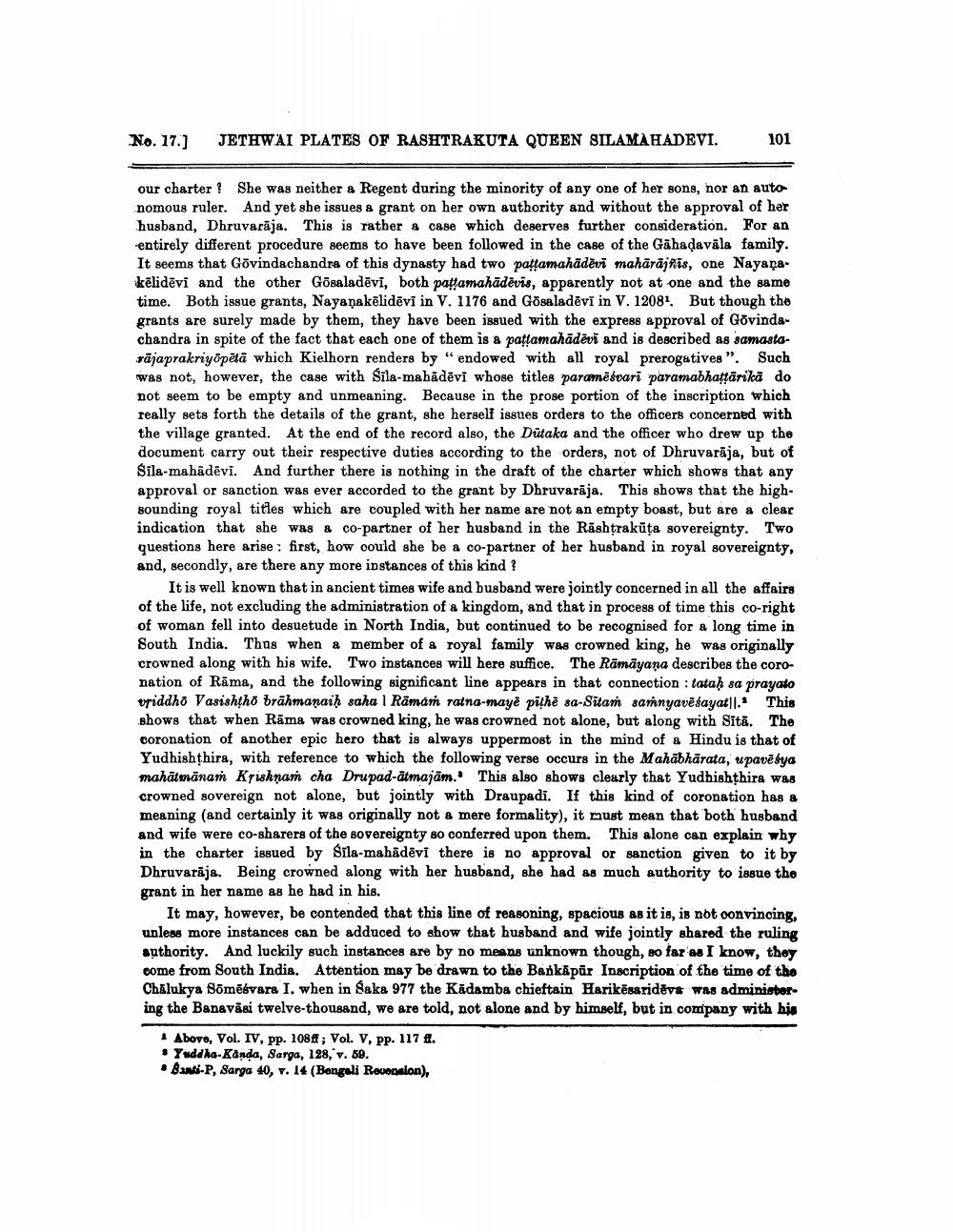________________
No. 17.]
JETHWAI PLATES OF RASHTRAKUTA QUEEN SILAMAHADEVI.
101
our charter? She was neither a Regent during the minority of any one of her sons, nor an autonomous ruler. And yet she issues a grant on her own authority and without the approval of her husband, Dhruvaraja. This is rather a case which deserves further consideration. For an entirely different procedure seems to have been followed in the case of the Gahaḍavala family. It seems that Govindachandra of this dynasty had two paṭṭamahādēvi mahārājñās, one Nayanakēlidevi and the other Gōsaladevi, both paṭṭamahādēvis, apparently not at one and the same time. Both issue grants, Nayanakēlidēvi in V. 1176 and Gōsaladevi in V. 12081. But though the grants are surely made by them, they have been issued with the express approval of Govindachandra in spite of the fact that each one of them is a paṭṭamahādēvi and is described as samastarajaprakriyopētā which Kielhorn renders by "endowed with all royal prerogatives". Such was not, however, the case with Sila-mahādēvi whose titles paramèsvari paramabhaṭṭārikā do not seem to be empty and unmeaning. Because in the prose portion of the inscription which really sets forth the details of the grant, she herself issues orders to the officers concerned with the village granted. At the end of the record also, the Dutaka and the officer who drew up the document carry out their respective duties according to the orders, not of Dhruvaraja, but of Sila-mahādēvi. And further there is nothing in the draft of the charter which shows that any approval or sanction was ever accorded to the grant by Dhruvaraja. This shows that the highsounding royal titles which are coupled with her name are not an empty boast, but are a clear indication that she was a co-partner of her husband in the Rashtrakuta sovereignty. Two questions here arise: first, how could she be a co-partner of her husband in royal sovereignty, and, secondly, are there any more instances of this kind?
It is well known that in ancient times wife and husband were jointly concerned in all the affairs of the life, not excluding the administration of a kingdom, and that in process of time this co-right of woman fell into desuetude in North India, but continued to be recognised for a long time in South India. Thus when a member of a royal family was crowned king, he was originally crowned along with his wife. Two instances will here suffice. The Rāmāyaṇa describes the coronation of Rāma, and the following significant line appears in that connection: tataḥ sa prayato vriddho Vasishtho brāhmaṇaiḥ saha | Rāmam ratna-maye pithe sa-Sitam samnyavēsayat||. This shows that when Rama was crowned king, he was crowned not alone, but along with Sita. The coronation of another epic hero that is always uppermost in the mind of a Hindu is that of Yudhishthira, with reference to which the following verse occurs in the Mahabharata, upavēśya mahātmānam Krishnam cha Drupad-atmajām. This also shows clearly that Yudhishthira was crowned sovereign not alone, but jointly with Draupadi. If this kind of coronation has a meaning (and certainly it was originally not a mere formality), it must mean that both husband and wife were co-sharers of the sovereignty so conferred upon them. This alone can explain why in the charter issued by Sila-mahadevi there is no approval or sanction given to it by Dhruvaraja. Being crowned along with her husband, she had as much authority to issue the grant in her name as he had in his.
It may, however, be contended that this line of reasoning, spacious as it is, is not convincing, unless more instances can be adduced to show that husband and wife jointly shared the ruling authority. And luckily such instances are by no means unknown though, so far as I know, they come from South India. Attention may be drawn to the Bankapur Inscription of the time of the Chalukya Sōmēsvara I. when in Saka 977 the Kadamba chieftain Harikesarideva was administering the Banavasi twelve-thousand, we are told, not alone and by himself, but in company with his
1 Above, Vol. IV, pp. 108ff; Vol. V, pp. 117 f. Yuddha-Kanda, Sarga, 128, v. 59.
Banti-P, Sarga 40, v. 14 (Bengali Recension),




